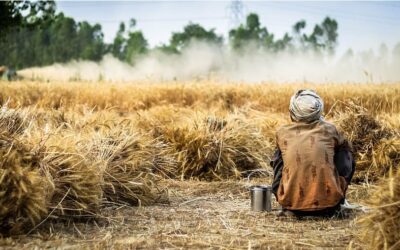World Pest Day 2021 – The need for a united front
In 2017, the 6th of June was declared World Pest Day to promote better understanding of pests and pest management. Pests have concerned agriculturists since the dawn of farming. There are records of techniques for warding off certain species from attacking crops dating back to 2500 BC. Since then, our ability to protect crops has improved exponentially, and consequently, our responsibility toward the ecosystem has also grown. Pest management today is a complex and scientific field that promotes innovative practices with implications beyond agriculture. The field has recognised challenges in controlling pests that can only be addressed if governments, science institutes, policy makers and farmers take coordinated action.
The 2019 desert locust upsurge manifested many of the concerns we have about the current practices of pest management. The pall of locusts spread across the Sahara, affecting countries from Mauritiana to India, including Kenya and the nations in the horn of Africa. Caused by a perfect storm of climatic, environmental and man-made conditions, this was the largest upsurge of desert locusts the world had seen in 25 years, and it threatened the lives of millions of people by destroying food and livelihoods. At the time of writing this, the immediate danger posed by the locusts has been averted by mass spraying of insecticides. As of March 2021, 1.8 million liters of chemical pesticides have been sprayed over 4.35 million acres of land, a process costing $118 million. Scientists say that we could still experience the after effects of this move, which they are yet to fully quantify.
What we do know is that the pesticides that were approved for use against the locusts by governments and the FAO are also harmful to bees, birds, a variety of insects, and also to fish. The chemicals are toxic by definition and, though they don’t harm mammals, can disturb an ecosystem. They seep into the water table, the soil, and the things that grow on it. “We are not hiding what conventional pesticides are,” says Cyril Ferrand, FAO resilience team leader in Nairobi. This was the worst locust invasion that Kenya had seen in 70 years. Speaking of Kenya specifically, Keith Cressman, the FAO’s senior locust forecaster says, “They had no equipment, no expertise, no pesticides, no aircraft, no knowledge.” [Source: National Geographic] This was a desperate time and our governments and non-government organisations resorted to desperate measures.
It is important to note here that non-toxic biological alternatives to these pesticides have been available for decades. The fungus Metarhizium is recommended by the FAO to control locusts. The biopesticide is effective against locusts only and does no other damage. Surprisingly, because it is only effective in this specific use-case, Metarhizium is considered a less profitable product. The pesticides that sell, the ones that agrochemical companies keep a good stock of, the ones that come in handy during an unpredictable crisis, are those that affect a large spectrum of pests.
The desert locust upsurge wasn’t the first such case of pest invasion that we have faced, and it won’t be the last. Pests can be viewed as a natural byproduct of agriculture. At the same time, we also need to recognise that around 30–40% of potential global food, fiber, and feed produced are lost to pests (insects, nematodes, diseases and weeds) annually. That is an estimated $300 billion eaten away globally. Scientists believe that losses are higher in developing countries. Considering the rate at which the human population is growing and is estimated to grow, this is a cause for concern.
Pests need to be countered, but not simply by spraying toxic chemicals at them. That kind of approach will no longer do, especially when we have the technology and know-how to do better. Experts recommend an integrated approach, one that incorporates better forecasting and monitoring technologies, with controlled spraying of crops with biocontrol products, with developing pest-resistant seeds, and other, safer methods. All of these policies will take time to take root, and have to be supported by stronger partnerships across the board. Here are some examples of pest control practices that have been put in place internationally:
- In Colombia, researchers from the International Center for Tropical Agriculture (CIAT) bred a strain of cassava to be resistant against high whitefly. This variant outperformed regional varieties without the need for pesticides. Similar projects have worked with maize in West and Central Africa, and cowpea in Nigeria.
- In Bangladesh, farmers have been assisted with monitoring and forecasting technologies by the International Maize and Wheat Improvement Center (CIMMYT) to help track and control infestations.
- In Tanzania, the International Institute of Tropical Agriculture (IITA) developed the product Green Muscle, which has been effective against red locusts, albeit only against hoppers and not fully matured adults.
Methods like this come under what is called Integrated Pest Management (IPM). The FAO defines IPM as “an ecosystem approach to crop production and protection that combines different management strategies and practices to grow healthy crops and minimize the use of pesticides.”
With all the research that’s happening today, I’m confident that new, ingenious technologies will be developed in pest management to take us into the future. But what is needed more urgently is close partnership between governments, NGOs, research institutions, donors, investors, civil societies and farmer communities in standing for responsible pest management. There are innumerable threats to crops when they are growing and after they have been harvested, and there is no one-size-fits-all solution to tackle them all. The thing that all of them have in common is that they affect the small-holder farmer the most. Farmers stand at the forefront in cases of pest invasion, and stand to lose the most. In these trying times, I want to stress the importance of presenting a united front against the issues we face, and having the smallholder farmer at its centre. I am confident as ever that as farmers grow, we grow.
Continue Reading
World Environment Day – Revisiting “Only One Earth”
Climate change is real. It affects developing nations disproportionately as compared to developed nations. Developing nations should not wait for help to do good for the environment but work towards ensuring that these challenges are met headlong. They should know that sustainability goals and development is not mutually exclusive.
World Food Crisis – How Africa can be the long-term solution
Africa has abundant resources to be the food factory for the world. This holds true especially for vegetable oil crops such as Sunflower, palm, soybean and rapeseed. Tanzania provides ideal conditions for growing sunflower at scale and supply it’s oil to the major consuming nations such as India.
Earth Day – Rising to the challenge of saving ourselves
We need to find solutions to ensure we can not just stop but reverse climate change. One solution is regenerative agriculture that can not only improve the yields for the farmers, but also reduce their carbon footprint.




0 Comments